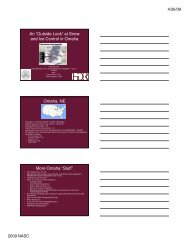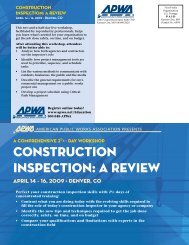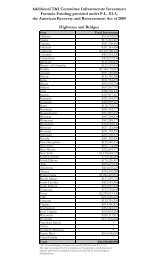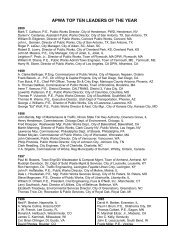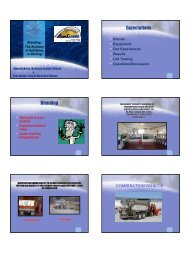Anti-icing & De-icing using a 30:70 ratio of liquid/dry material Topics ...
Anti-icing & De-icing using a 30:70 ratio of liquid/dry material Topics ...
Anti-icing & De-icing using a 30:70 ratio of liquid/dry material Topics ...
- No tags were found...
You also want an ePaper? Increase the reach of your titles
YUMPU automatically turns print PDFs into web optimized ePapers that Google loves.
InstallationInstallation <strong>of</strong> the STRATOS spreader was completed at the <strong>De</strong>partment’s Fleet Services facility inBangor. This installation took approximately 6 to 8 hours to complete. Fleet Services personnel involvedwith the installation indicated there is “much less wiring” and “fewer hydraulic connections” than wheninstalling the conventional systems. The hydraulic system is self–contained on the spreader and requiresonly two hydraulic fittings. Conventional systems require a minimum <strong>of</strong> three fittings. The only issue toarise during the installation was with the incompatibility <strong>of</strong> the speed sensor sending unit on the vehicleand the STRATOS receiving unit. This condition is related to the age <strong>of</strong> the vehicle and should not be anissue with future installations on newer trucks.It is also interesting to note that at no time was the hydraulic system overtaxed by the amount <strong>of</strong> <strong>material</strong>requested or the corresponding travel speed <strong>of</strong> the truck. With many installations <strong>of</strong> experimentalequipment over the past several years, the <strong>De</strong>partment has experienced instances where the existinghydraulic systems on the vehicles were not capable <strong>of</strong> providing adequate hydraulic flow or pressure tooperate the equipment.Numerous times throughout the installation, MAINEDOT personnel commented on the overall qualityand simplicity <strong>of</strong> the STRATOS spreader.Equipment Features <strong>of</strong> the STRATOS SpreaderSpinner AssemblyPhoto 1 Photo 2A spinner or disc located at the back and center <strong>of</strong> the hopper (photo 1) spreads the <strong>material</strong> in a “ribbon–like” pattern. This pattern can be increased to treat two lanes when desired. The disc can also bepositioned to treat closer to the centerline when necessary, minimizing the loss <strong>of</strong> <strong>material</strong> to the shoulder<strong>of</strong> the roadway. Each <strong>of</strong> these features is adjusted <strong>using</strong> a simple, easy to use controller (photo 2) locatedin the cab <strong>of</strong> the vehicle.3



